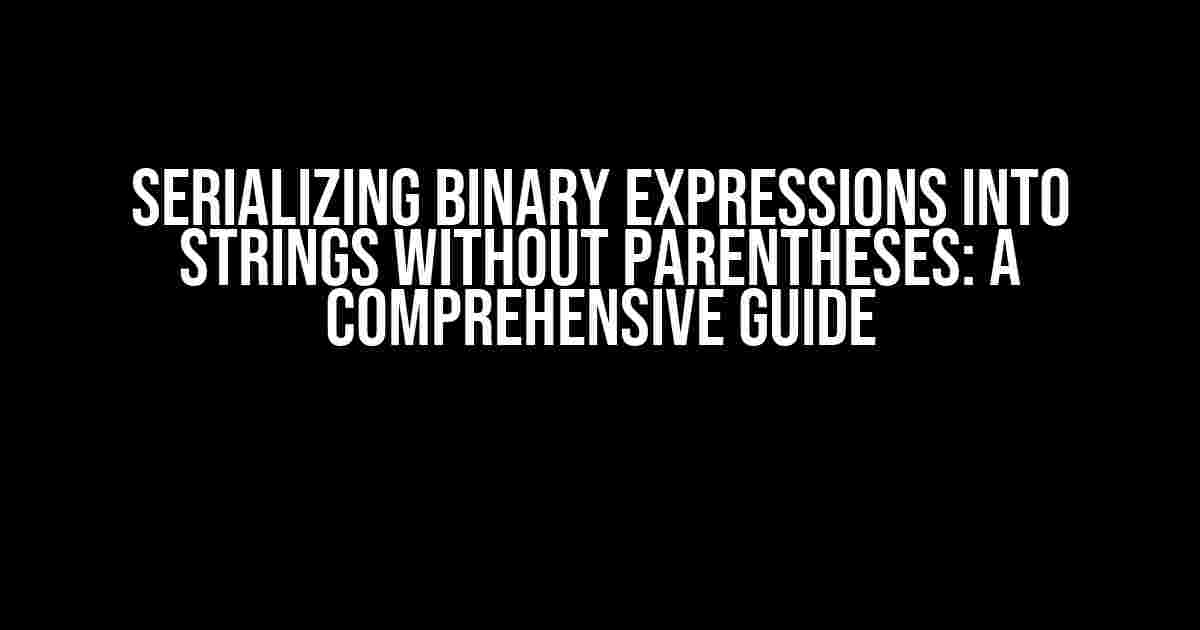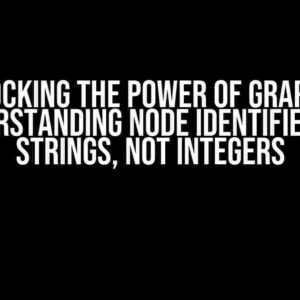When working with binary expressions, serializing them into strings can be a daunting task, especially when dealing with complex expressions containing multiple operators and operands. One common challenge is how to represent these expressions as strings without using parentheses, which can make the resulting string harder to read and understand. In this article, we’ll explore the art of serializing binary expressions into strings without parentheses, providing clear and direct instructions, and explanations to help you master this skill.
Understanding Binary Expressions
Before we dive into serializing binary expressions, let’s briefly review what they are and how they’re constructed. A binary expression consists of three parts:
- An operator (e.g., +, -, \*, /, etc.)
- A left operand (e.g., a number, variable, or another expression)
- A right operand (e.g., a number, variable, or another expression)
For example, the expression `2 + 3` is a binary expression, where `+` is the operator, `2` is the left operand, and `3` is the right operand.
Why Serialize Binary Expressions into Strings?
Serializing binary expressions into strings is useful in various scenarios:
- Data storage and retrieval: When storing binary expressions in a database or file, serializing them into strings allows for efficient storage and retrieval.
- debugging and logging: Serializing binary expressions into strings facilitates debugging and logging, enabling you to inspect and analyze expressions more easily.
- Communication between systems: When communicating between different systems or languages, serializing binary expressions into strings provides a common format for exchange.
The Challenge of Serializing Binary Expressions without Parentheses
When serializing binary expressions into strings, the most significant challenge is representing the expression in a way that accurately preserves its structure and precedence. Parentheses are often used to clarify the order of operations, but omitting them can make the resulting string harder to read and understand.
For example, consider the expression `(2 + 3) * 4`. When serialized without parentheses, this expression becomes `2 + 3 * 4`, which can be ambiguous and difficult to interpret.
A Step-by-Step Guide to Serializing Binary Expressions without Parentheses
To serialize binary expressions into strings without parentheses, follow these steps:
Step 1: Define an Order of Operations
Establish a clear order of operations to ensure that the serialized string accurately represents the original expression. A common approach is to use the following order:
- Exponentiation (e.g., `^`, `**`)
- Multiplication and Division (e.g., `*`, `/`, `%`)
- Addition and Subtraction (e.g., `+`, `-`)
This order ensures that operations with higher precedence are evaluated first, ensuring the correct serialization of the expression.
Step 2: Determine the Operator Precedence
For each operator in the expression, determine its precedence based on the order of operations established in Step 1. This will help you decide how to serialize the expression to maintain the correct order of operations.
For example, in the expression `2 + 3 * 4`, the `*` operator has higher precedence than the `+` operator. Therefore, you would serialize the expression as `2 + 3 * 4`, ensuring that the multiplication is evaluated first.
Step 3: Serialize the Expression
Using the determined operator precedence, serialize the expression into a string by concatenating the operands and operators in the correct order. Pay attention to the following:
- Place the operator between the operands, ensuring correct spacing.
- Use the correct notation for operators (e.g., `*` for multiplication, `/` for division).
- Avoid using parentheses unless necessary for clarity or to disambiguate the expression.
For example, the expression `(2 + 3) * 4` would be serialized as `2 + 3 * 4`, whereas the expression `2 + 3 * (4 – 1)` would be serialized as `2 + 3 * (4 – 1)` to maintain clarity.
Examples and Edge Cases
Let’s explore some examples and edge cases to illustrate the serialization process:
| Expression | Serialized String |
|---|---|
| (2 + 3) * 4 | 2 + 3 * 4 |
| 2 + 3 * (4 – 1) | 2 + 3 * (4 – 1) |
| (2 – 1) * (3 + 2) | 2 – 1 * 3 + 2 |
| 2 ^ 3 * 4 | 2 ^ 3 * 4 |
| 2 / (3 + 2) | 2 / 3 + 2 |
Note how the serialized strings maintain the correct order of operations and precedence, ensuring accurate representation of the original expressions.
Common Mistakes and Pitfalls
When serializing binary expressions into strings without parentheses, it’s essential to avoid common mistakes and pitfalls:
- Ambiguous expressions: Omitting parentheses can lead to ambiguous expressions, making it difficult to determine the correct order of operations.
- Operator precedence: Failing to establish a clear order of operations can result in incorrect serialization, leading to errors or misinterpretation.
- Spacing and notation: Incorrect spacing or notation can make the serialized string difficult to read or understand.
Conclusion
Serializing binary expressions into strings without parentheses requires careful consideration of operator precedence, expression structure, and notation. By following the steps outlined in this guide, you’ll be able to accurately and efficiently serialize binary expressions into strings, ensuring that the resulting string accurately represents the original expression. Remember to avoid common mistakes and pitfalls, and always prioritize clarity and readability in your serialized strings.
Remember, practice makes perfect! Try serializing different binary expressions into strings without parentheses to hone your skills.
Final Thoughts
Serializing binary expressions into strings without parentheses is a valuable skill that can simplify data storage, debugging, and communication between systems. By mastering this technique, you’ll become more confident in your ability to work with complex expressions and ensure accurate representation of your data.
What’s your approach to serializing binary expressions into strings without parentheses? Share your thoughts and experiences in the comments below!
Frequently Asked Question
Get ready to unravel the mysteries of serializing binary expressions into strings without parentheses!
What is the main challenge in serializing binary expressions into strings without parentheses?
The main challenge is to maintain the correct order of operations and ensure that the string representation accurately reflects the original binary expression, without relying on parentheses to group operators.
How do I handle operator precedence when serializing a binary expression into a string without parentheses?
A clever approach is to use a recursive algorithm that prioritizes operators based on their precedence, starting with the highest precedence operators first. This ensures that the string representation maintains the correct order of operations.
Can I use a stack-based approach to serialize a binary expression into a string without parentheses?
Absolutely! A stack-based approach can be an efficient way to serialize binary expressions. By pushing operators and operands onto a stack and then popping them off in the correct order, you can build the string representation without relying on parentheses.
How do I handle associative operators, such as addition and multiplication, when serializing a binary expression into a string without parentheses?
For associative operators, you can simply concatenate the operands and operators in the correct order, without worrying about parentheses. This is because associative operators follow the same precedence rules as the original binary expression.
Are there any specific language or platform considerations when serializing binary expressions into strings without parentheses?
Yes, you should be mindful of language-specific operator precedence rules, as well as any platform-specific requirements or constraints. For example, in some languages, the caret symbol (^) may have a different precedence than expected. Be sure to research and adapt your approach accordingly.





